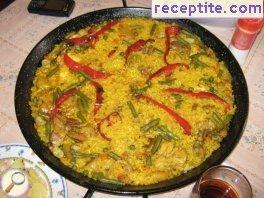Ingredients
400 g rice
200 g chicken, rabbit and pork
1 red pepper
100 g green beans
100 g peas
100 g artichoke
broth
10-12 tbsp vegetable oil (olive oil)
a pinch of saffron and turmeric, salt, 7-8 peppercorns, 1-2 bay leaves
lemon juice
3-4 cloves garlic
1 tsp color (colorants)

Photo added on
Photo author
anjelito
Method
In a saucepan fry the three types meat about 2-4 tablespoons of fat. Add 2 liters of water, cloves, bay leaves, turmeric, black pepper, saffron, salt. Boil to cook the meat. In a pan fry consistently and green beans, peas and artichokes. Cut into long strips pepper also fry. In a pan with a diameter of 37-42 cm Heat the remaining oil (if not left add optional), it fry rice. Here in Spain measures paella (rice) for one person is a handful (of one hand). Each handful of rice was added 200 ml the broth in which the meat is cooked. So dosed depending on the number of people who prepare paella. The rice add three types of meat, peas, beans and artichokes. Add coloring and stir well to distribute the product evenly in pan. Pieces of red pepper are used for decoration. dish dovaryava low heat on stove. Served with tray table and optional portions to add lemon juice.
Containers:
Difficulty
Difficult
Tested
0 users

Comments
yellow dye listed in products is E 102 tartratsin - actually cheaper substitute for saffron. For people intolerant to aspirin, berries and some other allergies tartratsin is quite dangerous. Furthermore tartratsin is the main suspect culprit causing Attention deficit hyperactivity disorder in children, in combination with benzoates. And more: asthmatics seizure as tartratsin released histamine in the body. Tartratsin was banned in the European Union, but after a while just for Spain, where its use is simply infinite, and the people seem not to care was admitted again. Interesting that the largest producers of saffron most often replaced with chemistry: Spain, Morocco, Iran. Or more precisely so accustomed to their dishes are yellow, that they have no money for saffron put their chemistry in pots.
Saffron has nothing to do with koloranteto which colored rice and other dishes here. As to 4f do not have money for saffron, opinion, you little preuveli4eno, sure you do as I live in Spain over 10 years. People pay attention to healthy eating and on the average life expectancy is between 80 and 85 years. The main menu of the Spaniards consists of veal, fish, seafood and olive oil.
This does not change the fact that 50 years ago the Spaniard is not Zanetti, what tartratsin, today mass and without thinking puts it in his hara. Do not forget that those Spaniards who are now 85 years old, have not grown with paella, colored with colorants, and perhaps with pure saffron or turmeric. Do not attack Spain or lives there, do not get me wrong, but the chemistry remains chemistry and used just to reduce costs - whether independence in the food industry or at home. For the recipe itself - no doubt it is delicious, I like Spanish cuisine. I think a similar recipe I have read here on the site of Lorena, if I remember well, and that I liked.
In fact, saffron should be added in very large quantities to change the color of the dish. Given that it is the most expensive spice is common to replace. Koloranteto was banned only in Norway. If there was a clear and unequivocal evidence of harm from its use would not have it on the market in other European countries.
On the contrary, was banned here in Germany and Austria, as Austria was forbidden nawae lighting objects. The ban was lifted after serious debates to be respected equality in the EU. And last year, summer, any food or drink that contains it, have to be marked with warning text complex as an additional label OUTSIDE ingredients - just because it causes severe allergic reactions and the aforementioned syndrome. Spain is the only country in Europe where the market freely, and where used mass (the same applies to Morocco, but not EU) So it seems the warning text http: // www. vzhh. de / upload / VerbraucherzentraleHamburg / images / ernaehrung / Internetbild_Wasabi_Erdnusse. JPG